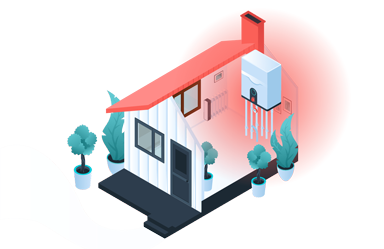Best Portable Air Conditioners to Keep You Cool in 2024
Portable air conditioners are air conditioners designed to cool a single room that are easily movable between different locations. Portable air conditioners comprise a single, wheeled unit that contains all air conditioner components and an exhaust hose. The best portable air conditioners are small, quiet, and able to keep you cool in the hottest summer months.

Portable air conditioners work in the same way as other air conditioning units with a coil of refrigerant that is cooled by a compressor, heats up when it comes in contact with indoor air, and then deposits that excess heat outside.
The main difference between a portable air conditioner and other air-con types is that a portable air conditioner does not have an external condenser unit to dispel excess heat outside. Instead, portable air conditioners have a fan and an exhaust tube that blows hot air away from the condenser coil, down the tube, and out the window.
The best portable air conditioners are powerful enough to effectively cool a large room, cost-effective, and relatively quiet. The five best portable air conditioners on the market are as follows.
- Pinguino PAC EM82
- Meaco 14000
- The Amcor SF8000E
- The AEG ChillFlex Pro
- The Black and Decker BAC4000
A major concern for a lot of homeowners looking for a portable air conditioner is storage space. A lot of the more powerful portable air conditioners take up a lot of space in your living room or bedroom, but some are designed with a smaller footprint. The five smallest portable air conditioners are those listed below.
- MeacoCool MC Series 7000
- Challenge 5000
- Challenge 7000
- Avalla S-80
- Tangzon 7000
Many people look for portable air conditioners to cool their bedrooms so they can get a better night’s sleep, and these air-cons must have low noise levels. The five best portable air conditioners for the bedroom are as follows.
- BLU-09
- Avalla S-80
- MeacoCool MC Series 7000
- HomCom 8000
- Meaco 14000
The final consideration for a lot of buyers is price. Portable air conditioners are often intended for temporary use during a couple of months when the UK becomes uncomfortably hot. So many buyers want a relatively inexpensive air conditioning solution. The five most affordable portable air conditioners are as follows.
- Challenge 5000
- BLU-09
- Tangzon 7000
- HomCom 7000
- Princess Mobile Air Conditioner 7000
Most portable air conditioners cost in the range of £300 – £500 to buy. Portable air conditioners do not require a professional installation, so there are no installation costs. Running a portable air conditioner for 6 hours a day for a month costs in the range of £50 – £180 depending on your model, use frequency and intensity, and the electric unit rates.
Few people in the UK have central air conditioning installed in their homes. Summers are historically mild in the UK, so most people are willing to put up with the odd week of discomfort. That said, climate change has increased the length and intensity of the UK’s summer heat waves so a lot of Brits are increasingly turning to different options like fans and portable air conditioners to stay cool during the hottest months. Air conditioning is especially important if you are at risk for health conditions like heat stroke. A portable air conditioner is consequently a good compromise because it’s the most affordable version of air conditioning and can be used where and when you need it for several hours at a time.
The best alternatives to portable air conditioners are fans, evaporating coolers, and window air conditioners. Fans and evaporating coolers are cheap alternatives to portable air conditioners that can work in moderate heat. Fans create a nice breeze while evaporating coolers use the cooling effect of water evaporation to cool the air a bit. However, neither work particularly well in the sweltering heat. Window air conditioners are proper air conditioners that are generally more expensive than portable air conditioners. They are installed in an open window and offer more cooling power than portable air conditioners, but cost more to purchase.
Best portable air conditioners in the UK
The five best portable air conditioners in the UK are as follows.
- Delonghi Pinguino PAC EM82: The Delonghi Pinguino PAC EM82 is one of the best portable air conditioners in the UK in terms of advanced features and the quality of the build.
- Amcor SF8000E: The Amcor SF8000E is the best portable air conditioner in the UK for value-for-money at just £250 – £330.
- AEG ChillFlex Pro: The AEG ChillFlex Pro is one of the best “all-rounder” portable air conditioners on the UK market with a host of advanced features and an impressive 12,000 BTU capacity.
- Black + Decker BXAC4000: The Black and Decker BXAC4000 is one of the best portable air conditioners in the UK for quality of build and durability.
- Meaco 14,000: The Meaco 14,000 is both one of the highest-capacity portable air conditioners on the market and one of the quietest.
Delonghi Pinguino PAC EM82 portable air conditioner
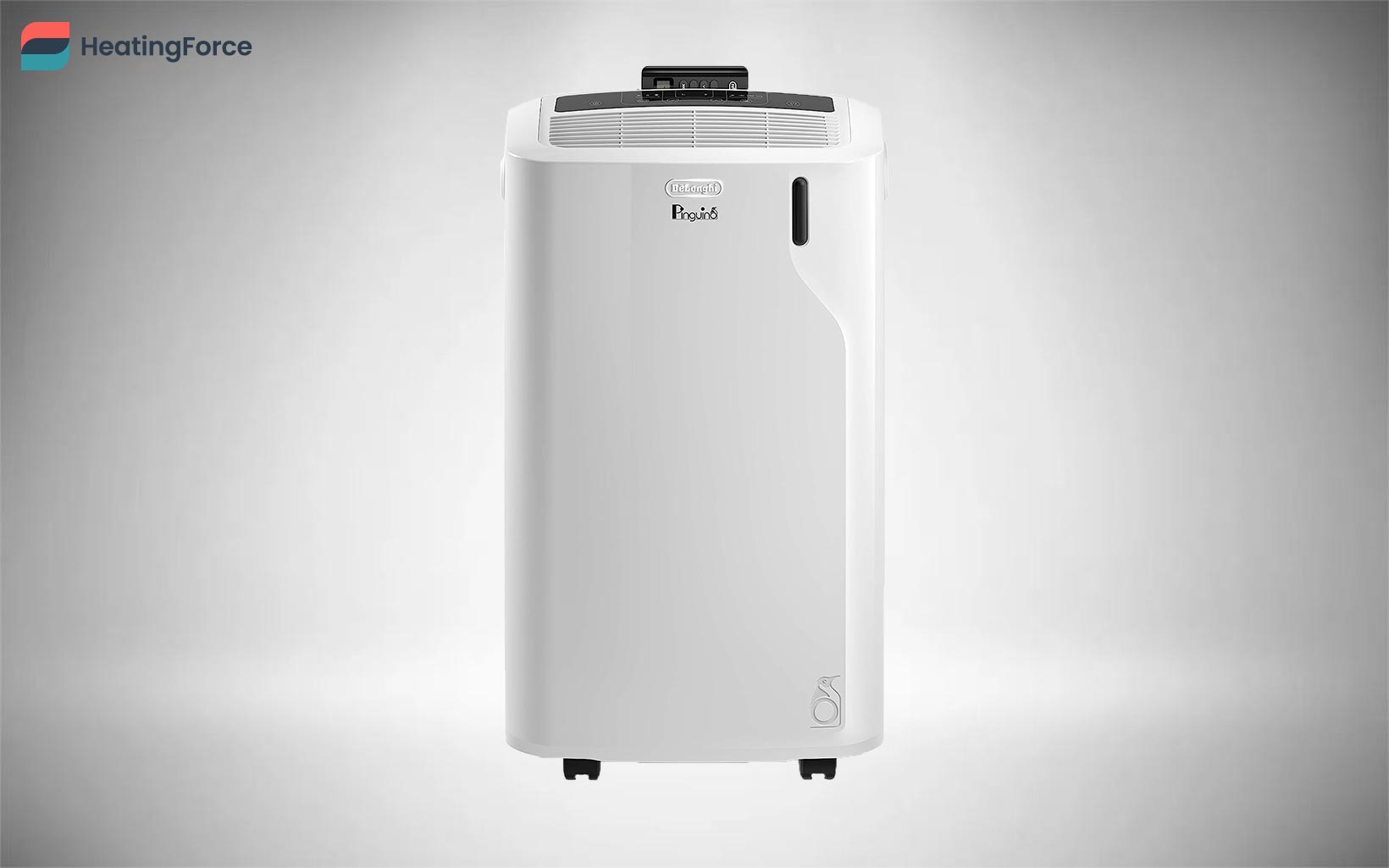
The Delonghi Pinguino PAC EM82 is one of the best air conditioners available in the UK because of its advanced features. Features include an easy-to-use LED control panel, a 24-hour timer that allows you to set the PAC EM82 to your lifestyle, and a condensate recycling system that helps use excess moisture to keep your home cool. One of the more interesting features the EM82 brings to the table is the quiet mode. The EM82 normally runs at around 63 dB of noise, which is the sound of a loud dishwasher and is typical of portable air conditioners. The model’s quiet mode brings the volume down substantially to just 47 dB.
The PAC EM82 is average among portable air conditioners in terms of size and weight. The unit has a height of 70 cm, a width of 43 cm, and a depth of 35 cm, so compact enough to store in a closet in the winter months. The EM82 weighs 33kg (like most other portable air conditioners), so it’s a bit too heavy to lift without help.
The exhaust duct on the EM82 is included in your purchase alongside the rest of the window kit and measures 120 cm in length. The unit (like all other portable air conditioners) only works if you connect the unit to an open window. You need to leave at least 30 cm between the back of the unit and the nearest wall or window for safety reasons so factor that space when positioning the unit.
One downside of choosing the Delonghi Pinguino PAC EM82 is that it is a lot less powerful than other premium portable air conditioners. The cooling capacity of the EM82 is 9,400 BTUs, which is only enough to cool a small or medium-sized living space. Conversely, a major advantage of the PAC EM82 is that it is an environmentally-friendly option due to its use of R290 as a refrigerant. R290 is a refrigerant-grade propane and has less potential to damage the ozone layer than other refrigerants like Freon. R290 also has a higher ignition temperature than most other refrigerants at 470C, which makes it a safer choice.
The Delonghi Pinguino PAC EM82 purchase costs are on the upper end of the scale. Below is a table that summarizes the buying and running costs of an EM82
| Delonghi Pinguino PAC EM82 | |
|---|---|
| Purchase cost | £650-£800 |
| Power consumption | 1.0 kWh |
| Running cost per hour | £0.34 – £0.70 |
| Running cost per month* | £61.20 – £126 |
Overall, the PAC EM82 is an appropriate choice if you value the features the unit offers but is otherwise fairly standard among premium portable air conditioners in terms of its capacity and price. You may want to opt for the BLU-09 9000 as an alternative if budget is a concern. The BLU-09 has a similar capacity to the EM82 at 9,000 BTUs but comes at the lower price-point of £300 – £500.
Amcor SF8000E portable air conditioner
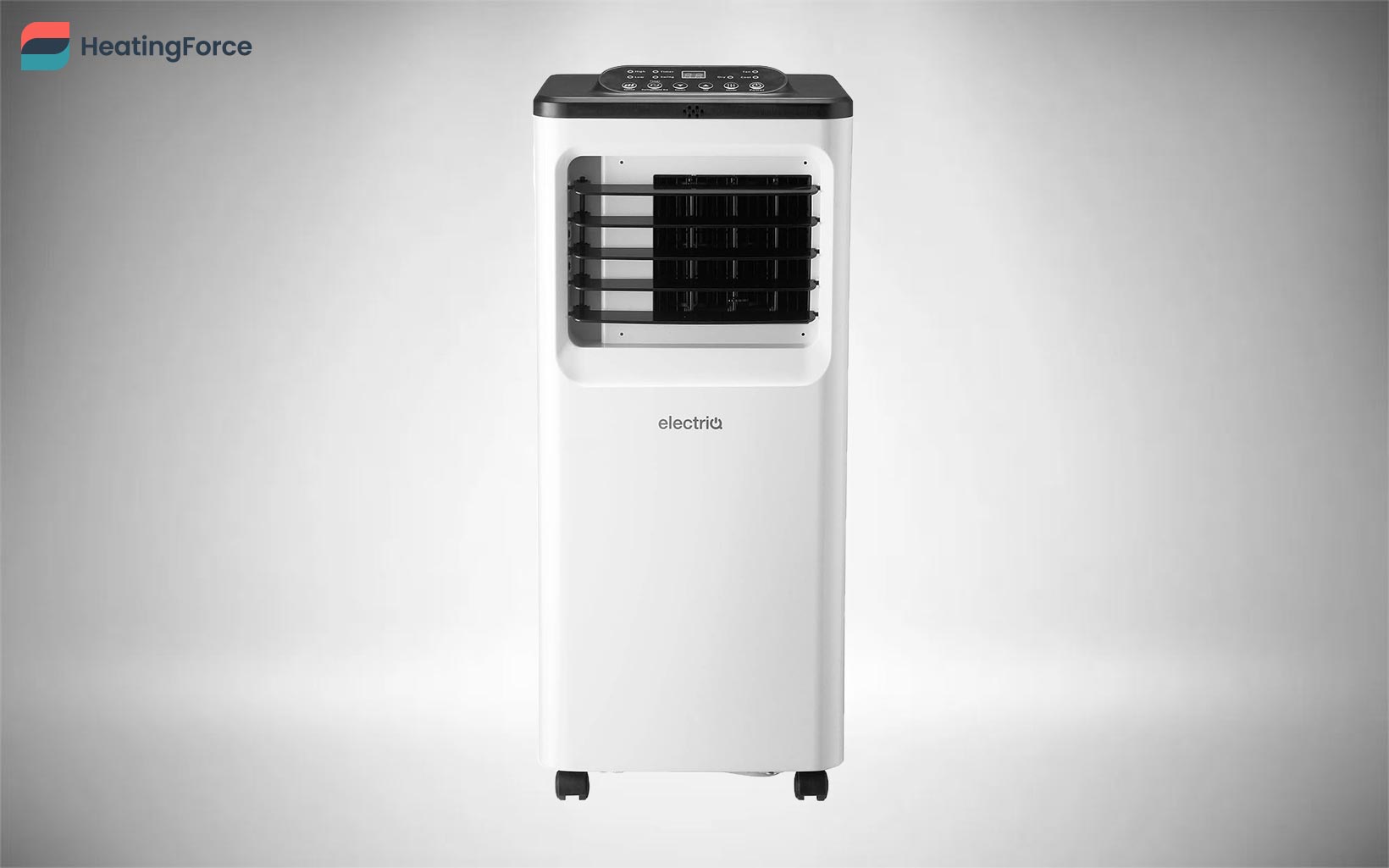
The Amcor SF8000E is among the best portable air conditioners in the UK because of its great value for money at a low price point. The Amcor SF8000E comes in at just £245 – £325 without sacrificing the quality of some of the best portable air conditioners on our list. The main features of the Amcor SF8000E are an easy-to-use control panel, a 24-hour timer, and a slim profile that fits into any room. Amcor have over 20 years of experience building durable air conditioners, so rest assured that the Amcor SF8000E is a quality model. You can also use the Amcor SF8000E to dehumidify your home if you’re feeling hot and muggy. The unit comes with a dehumidifier setting and can operate as a simple fan if you want airflow without air conditioning. Additionally, the Amcor SF8000E comes with a 1.5m exhaust duct that will connect the SF8000E to your air conditioner and a 12-month warranty.
SF8000E is a fitting option for smaller apartments since the unit has one of the smallest footprints of any premium portable air conditioner at 37cm x 32cm x 72cm. It’s easy to move the Amcor around from location to location as it weighs just 21kg. One downside of the Amcor SF8000E is that it has a lower cooling capacity than most portable air conditioners, at just 7,000 BTUs. That’s enough to cool a 250-300 square foot room. The benefit of its lower capacity is that the Amcor SF8000E is pretty cheap to run, consuming just .80 kWh per hour. The purchase costs are likewise low in comparison to other portable air conditioners. The table below offers a comparative guide to the costs associated with buying and running the Amcor SF8000E.
| Amcor SF8000E | |
|---|---|
| Purchase cost | £245 – £325 |
| Power consumption | 0.8 kWh |
| Running cost per hour | £0.27 – £0.56 |
| Running cost per month* | £48.96 – £100.80 |
The best alternative to the Amcor SF8000E is the MeacoCool MC, which also has a cooling capacity of 7,000 BTUs. The MeacoCool MC is slightly more expensive than the Amcor SF8000E at £300 – £400.
AEG ChillFlex Pro 12000 portable air conditioner
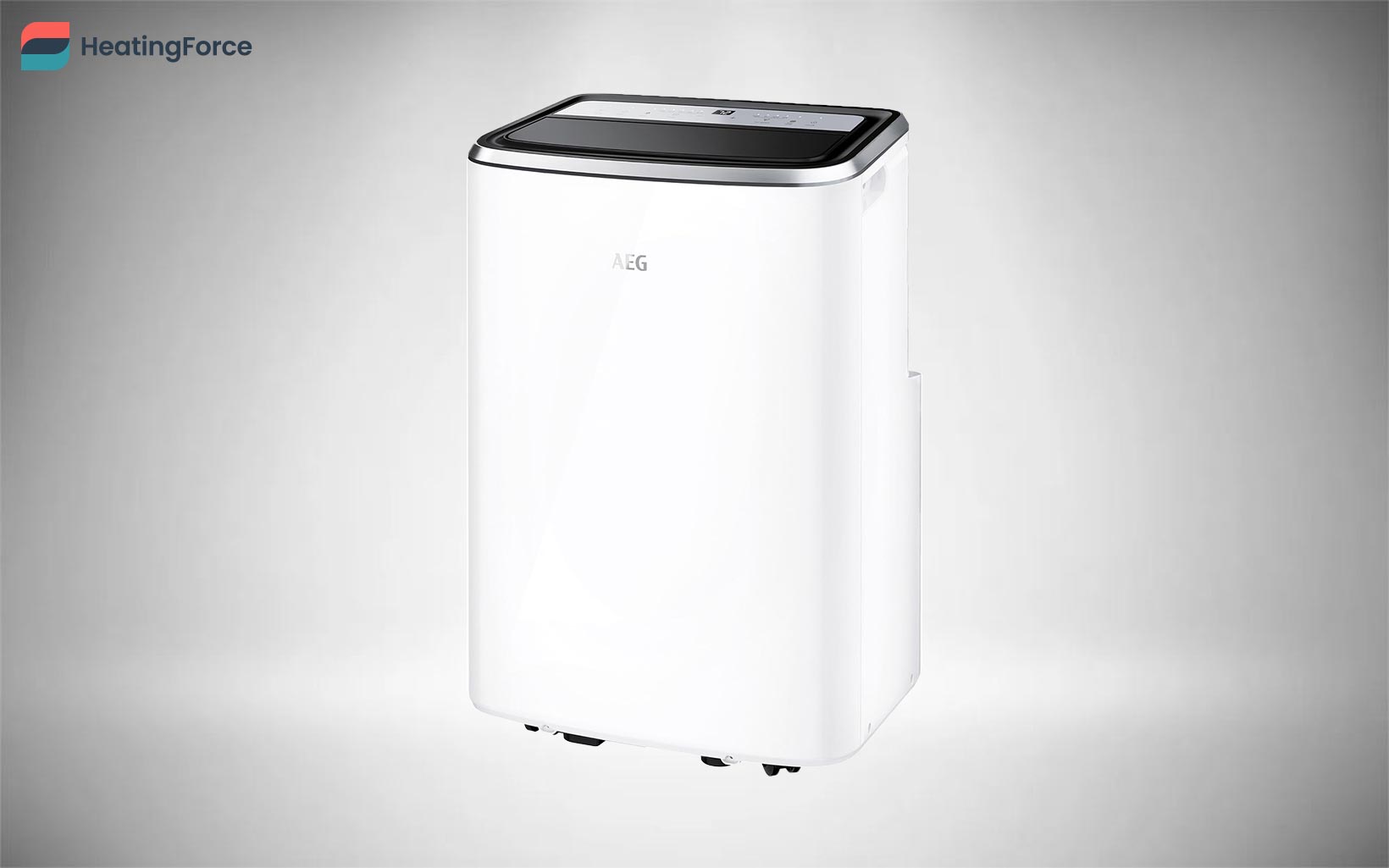
The AEG ChillFlex Pro is one of the best portable air conditioners in the UK because of its impressive cooling capacity of 12,000 BTUs, which is one of the highest on the market. A cooling capacity of 12,000 BTUs means the AEG ChillFlex Pro is powerful enough to cool a 500-square-foot space.
The key features of the ChillFlex Pro are a dehumidifier mode, three separate fan speeds, and a smart temperature setting, which selects a cooling temperature based on the room’s starting temperature. You’re able to set a timer to automatically shut off the unit up to 24 hours in advance.
There are three reasons you might not want to choose the ChillFlex Pro 12,000. Firstly, this model is quite cumbersome. The ChillFlex Pro is fairly heavy at 33kg and has a large footprint, with a depth of 47cm and a width of 38cm. The unit comes with caster wheels to help you move it around, but lifting it is not easy without help. Secondly, the ChillFlex Pro doesn’t come with a window kit. You get a 1.5-metre hose to connect to a window but no screen to seal up your window once you’ve installed the unit. Thirdly, this portable air-con model is pricey, so you may want to explore alternatives if budget is a major constraint.
Below is a table that offers the approximate costs of running the AEG ChillFlex Pro 12000.
| AEG ChillFlex Pro 12000 | |
|---|---|
| Purchase cost | £600 – £800 |
| Power consumption | 1.3 kWh |
| Running cost per hour | £0.44 – £0.91 |
| Running cost per month* | £79.65 – £163.80 |
The AEG ChillFlex is a good option if you need a lot of cooling capacity but don’t want to opt for a more permanent air conditioner. However, you may not want to buy an AEG ChillFlex Pro if you are on a tight budget or have limited storage space. A cheaper alternative to the AEG ChillFlex Pro is the Black and Decker BXAC400, which also has 12,000 BTUs of capacity and costs a little less at £500 – £700.
Black + Decker BXAC4000 portable air conditioner
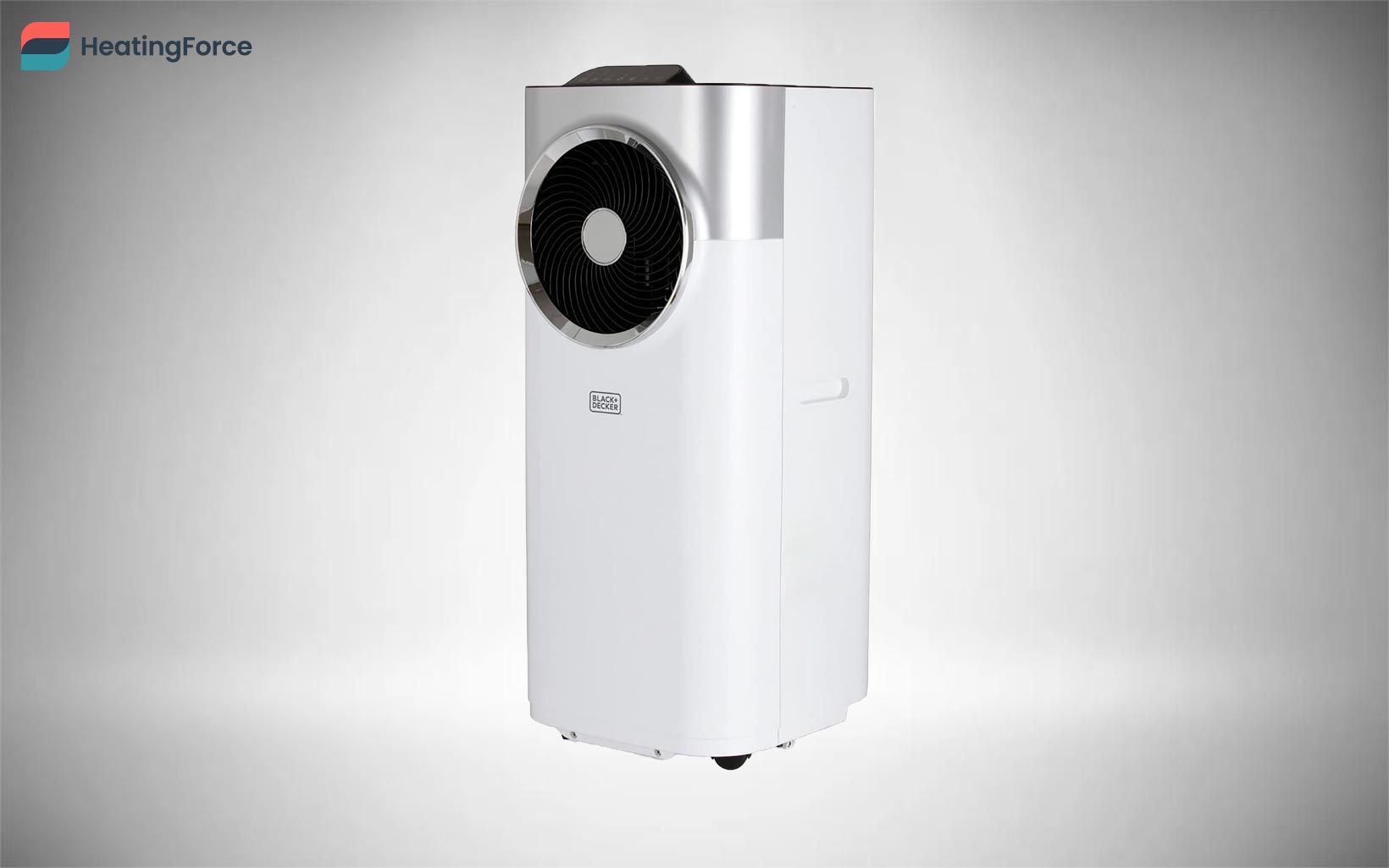
The Black and Decker BXAC4000 is one of the best portable air conditioners on the market because of its impressive cooling capacity, range of features, and reputation for durability. The Black and Decker BXAC4000 comes with a 24-hour timer, overheat protection, a three-speed fan, and a dehumidifier setting that’s able to extract up to 30 litres of moisture from your home’s air daily. An included remote control additionally allows you to change your settings from the other side of the room.
Price may be an issue if you’re budget-conscious. You get unremarkable noise levels from the BXAC4000, which produces 65 dB at its highest settings. Most portable air conditioners produce a similar level of noise, which is louder than other home appliances.
The Black and Decker BXAC4000 comes with a window kit that includes a window panel that fits in window openings of between 20.5 inches and 59 inches as well as a drain hose, 5-inch threaded exhaust hose, foam seal, and window bracket.
The table below offers a cost guide to running a Black and Decker BXAC40008GB.
| Black and Decker BXAC4000 | |
|---|---|
| Purchase cost | £500 – £700 |
| Power consumption | 1.3 kWh |
| Running cost per hour | £0.44 – £0.91 |
| Running cost per month* | £79.65 – £163.80 |
Meaco 14000 portable air conditioner
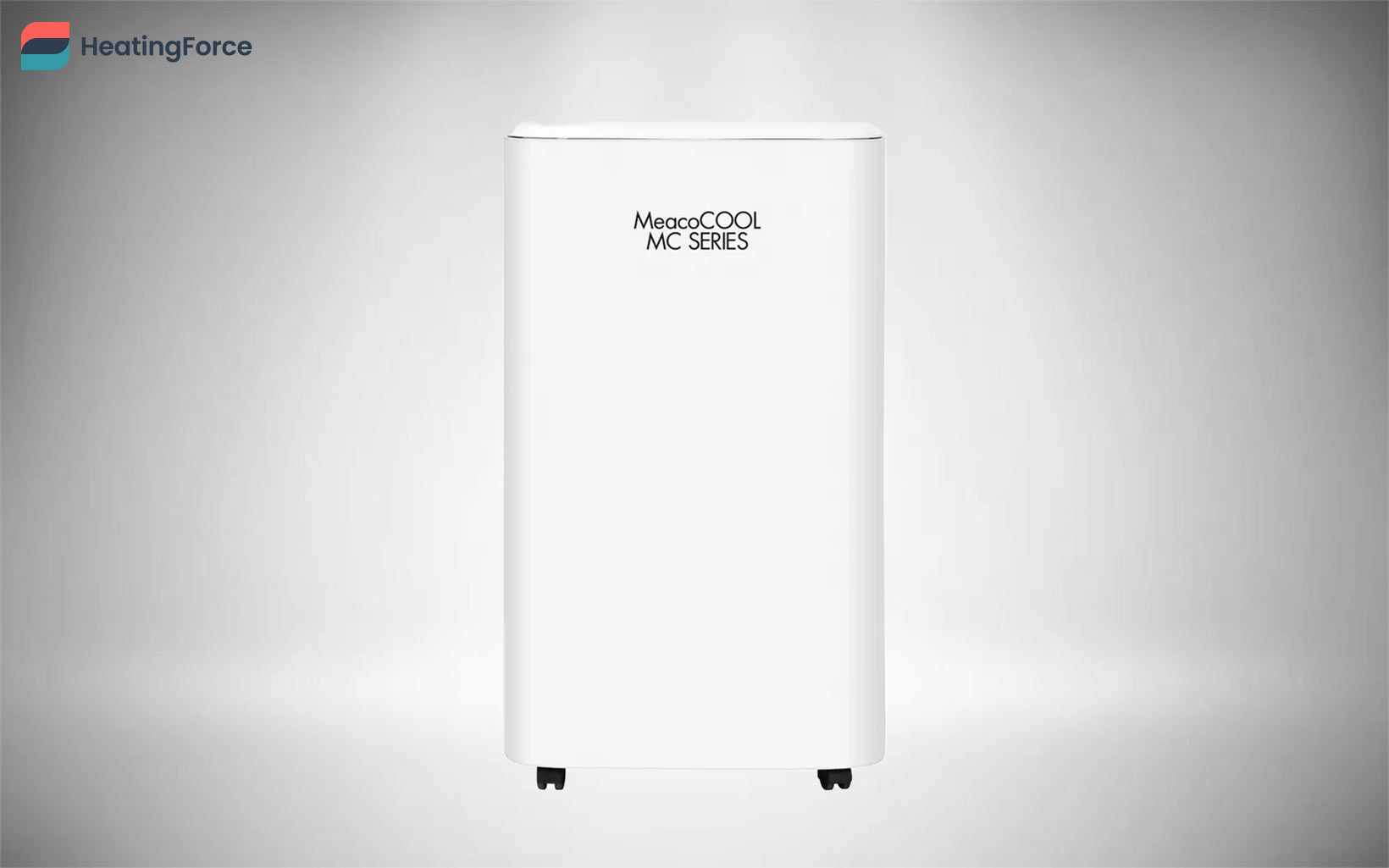
The Meaco 14000 is one of the best portable air conditioners on the market because of its whopping 14,000 BTU capacity, which is enough to cool a spacious living space effectively. The Meaco 14000 remarkably doesn’t make a massive racket despite its power capacity. The unit produces just 54 dB, around the volume of moderate rainfall, and is one of the quietest portable air conditioners on this list.
However, the unit is massive and not particularly elegant. The Meaco 14000 has a large, 35 cm x 47 cm footprint and a height of 76 cm, which makes it one of the tallest units on our list.
You don’t have to break the bank to buy the Meaco 14,000, as it’s moderately priced given the high capacity. Below is a table offering approximate purchase and operating costs for a Meaco 14000.
| Meaco 14000 | |
|---|---|
| Purchase cost | £450 – £650 |
| Power consumption | 1.5 kWh |
| Running cost per hour | £0.51 – £1.05 |
| Running cost per month* | £91.80 – £189 |
You should buy the Meaco 14,000 if you need the most powerful unit on the market to keep your home as cool as possible. You would struggle to find better value for money in terms of pure output, although the price will still make many prospective buyers blink twice. The best alternative to the Meaco 14,000 in terms of both capacity and price is the Black and Decker BXAC4000. The BXAC4000 has 12,000 BTUs of capacity and costs £400 – £700, a similar price-point to the Meaco 14,000.
Smallest portable air conditioners
The five smallest portable air conditioners are as follows.
- MeacoCool MC Series 7000: The MeacoCool MC Series 7000 has a depth of 13.8 cm and a width of 27.6 centimetres.
- Challenge 7000: The Challenge 7000 is one of the smallest portable air conditioners in the UK with a width of 32.9 centimetres and a depth of 31.8 centimetres.
- Avalla S-80 Portable Air Conditioner: The Avalla S-80’s depth of 31cm and width of 31.5 cm make it one of the smallest portable air conditioners on the market in the UK.
- Tangzon 7000: The Tangzon 7000 is one of the best small portable air conditioners on the market with a width of 31 cm and a depth of 31 cm.
- The Challenge 5000: The Challenge 5000 is one of the shortest portable air conditioners on our list with a height of just 63.4 cm. The Challenge 5000 has a footprint of 32.9 cm x 31.8 cm.
MeacoCool MC Series 7000 portable air conditioner
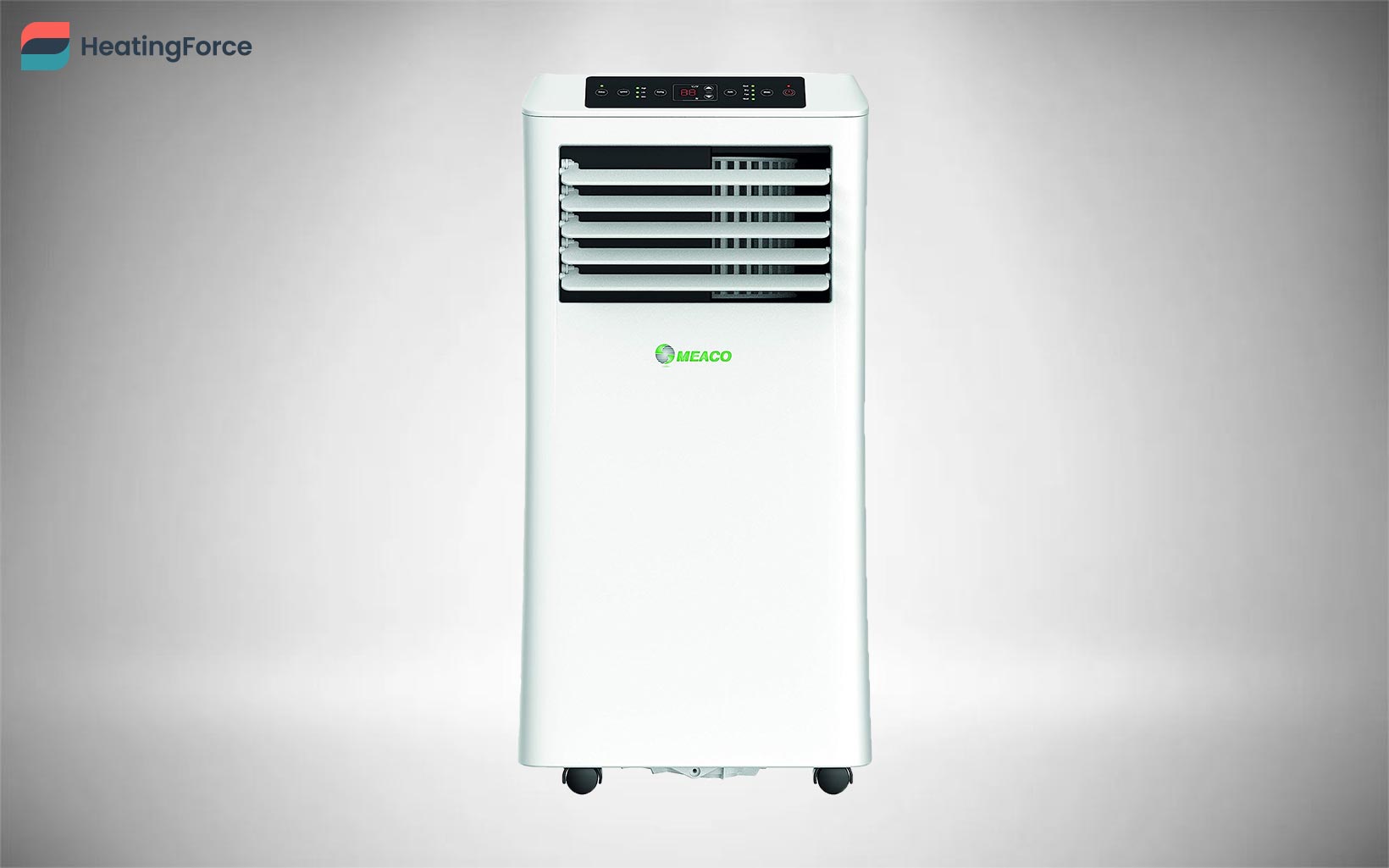
The MeacoCool MC is one of the smallest portable air conditioners on the market with a depth of 13.8 cm and a width of 27.6 cm. The footprint makes the MeacoCool MC Series 7000 an excellent choice if floor space is your biggest priority.
The MeacoCool MC has a mid-range cooling capacity of 7,000 BTUs, which is enough power to effectively cool a room of up to 300 square feet. Meanwhile, accessories that come with the MeacoCool include a remote control that allows you to adjust the unit’s settings from your couch; a short pipe for draining moisture from the humidity tank; and an adjustable window kit that should fit snugly into most windows or sliding doors.
Most people will find they can leave the MeacoCool MC running while they sleep given a noise level of just 53 dB at its lowest setting. 53 dB is quieter than most home appliances and is roughly the volume of moderate rainfall. The low-noise setting is “extra-low speed” so you might have to trade off some cooling for peaceful slumber, however.
You should consider the MeacoCool MC for its prices this is more affordable than many of the higher-capacity units on this list. Running costs are also fairly low for the MeacoCool MC. The table below offers an approximate cost guide to owning and operating a MeacoCool MC.
| MeacoCool MC | |
|---|---|
| Purchase cost | £300 – £400 |
| Power consumption | 0.78 kWh |
| Running cost per hour | £0.26 – £0.54 |
| Running cost per month* | £47.73 – £98 |
You should buy the MeacoCool MC Series 7000 if space is an absolute priority. The MC Series has a smaller footprint than any other portable air conditioning unit we looked at and outperforms many larger units in terms of output. That said, you may not need the smallest possible unit and might be willing to settle for a slightly larger alternative with a similar power output and price. Consider looking at the Challenge 7000, which has the same capacity as the MeacoCool MC 7000 and is a similar price. The Challenge 7000 is also slightly larger than the MC Series 7000.
Challenge 7000 portable air conditioner
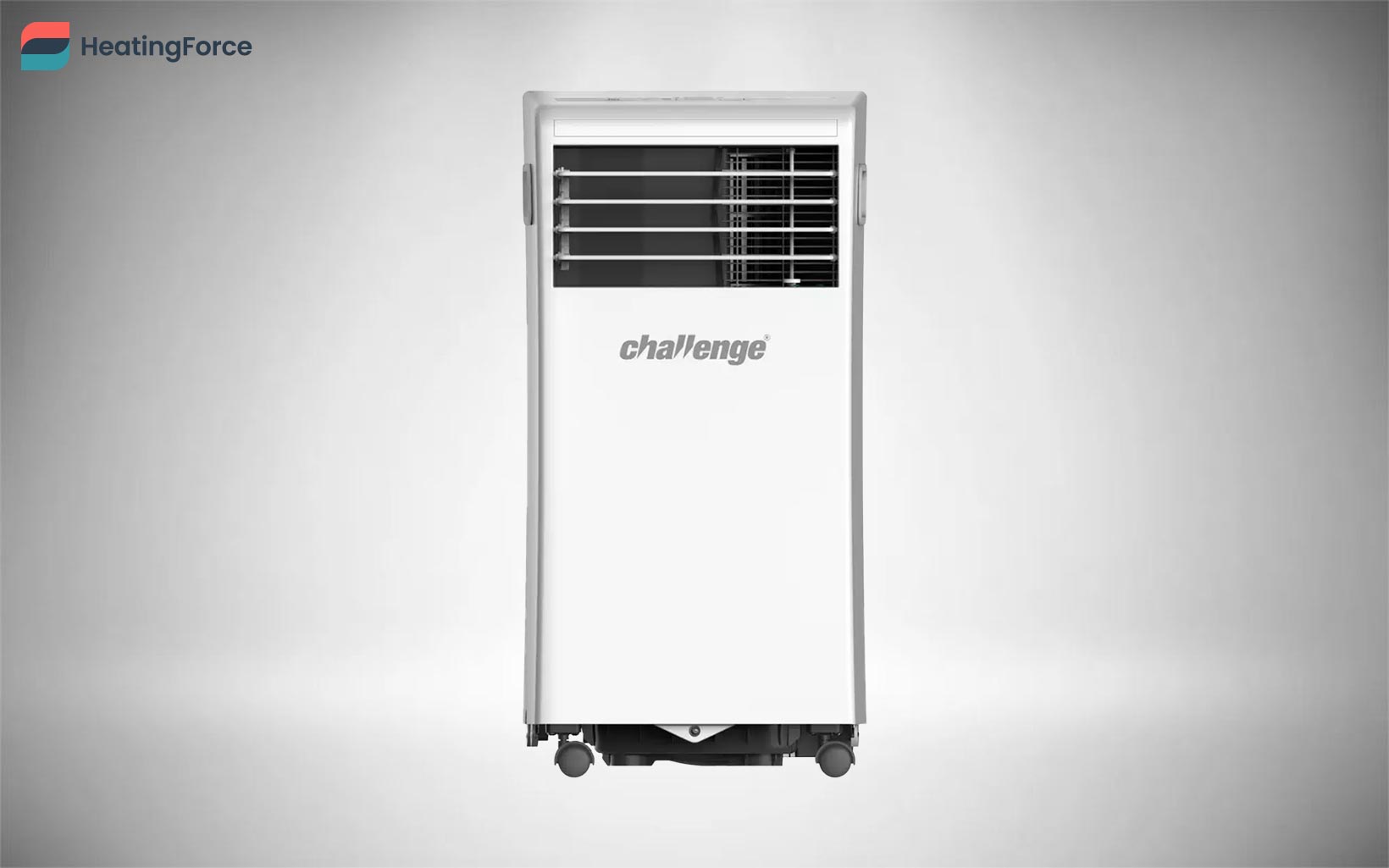
The Challenge 7000 is one of the smallest portable air conditioners in the UK with a width of 32.9 cm and a depth of 31.8 cm. The dimensions make the Challenge 7000 larger in footprint than MeacoCool MC Series 7000, but still small enough to fit into most smaller apartments. However, the unit’s size doesn’t mean you need to compromise on power. The Challenge 7000 has an output of 7,000 BTUs and can cool a room of 300 square feet, enough for most living spaces. Meanwhile, the noise level produced by the Challenge 7000 is typical of portable air conditioners at 62dB which is about as loud as background music in a store.
Additional features of the Challenge 7000 include castors for easy movement, 2 fan speed settings, and a remote control that requires 2x AAA batteries.
The price tag for the Challenge 7000 is what you would expect given its size and capabilities. The table below outlines the rough costs associated with owning and operating a Challenge 7000
| Challenge 7000 | |
|---|---|
| Purchase cost | £350 – £450 |
| Power consumption | 0.98 kWh |
| Running cost per hour | £0.33 – £0.69 |
| Running cost per month* | £59.97 – £123.48 |
The Challenge 7000 is a good option if you’re tight on space and need a portable air conditioner with enough cooling capacity for a single room. An effective alternative that you should consider if you’re looking at the Challenge 7000 is the MeacoCool MC Series 7000, which is smaller than the Challenge 7000 and has many of the same specifications.
Avalla S-80 portable air conditioner
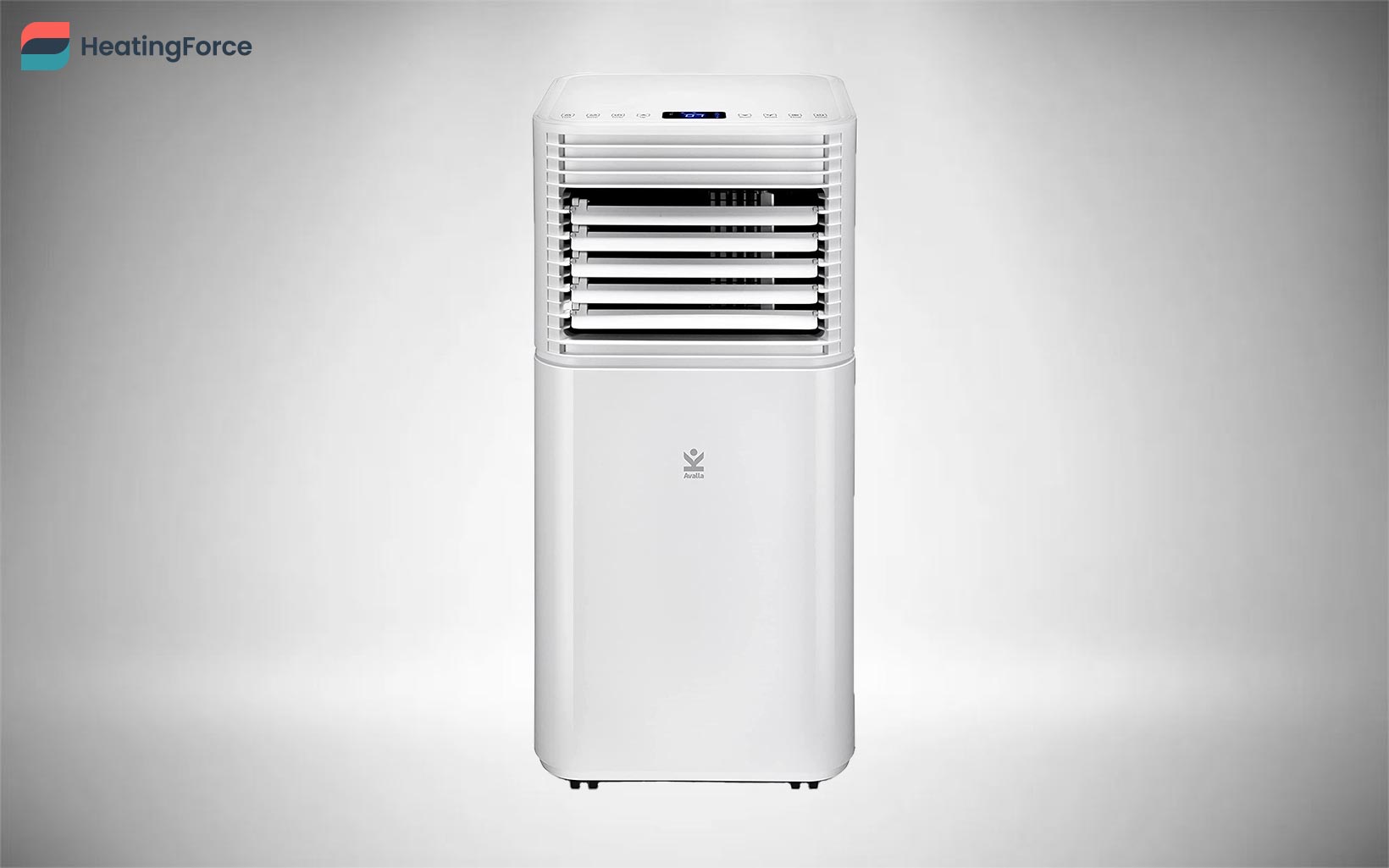
The Avalla S-80’s depth of 31cm and width of 31.5 cm makes it one of the smallest portable air conditioners on the market in the UK. The unit’s footprint is larger than the MeacoCool MC Series 7000 but smaller than the Challenge 7000.
There are two major advantages to choosing Avalla S-80 over other compact air-cons. Firstly, the S-80 has an incredibly low operating noise of just 50 dB. That’s the volume of moderate rainfall and is quieter than most home appliances. A 50 dB rating also makes the Avalla S-80 the quietest portable air conditioner that we could find. Secondly, the S-80 uses R290 as a refrigerant, which is less damaging to the ozone layer than other refrigerants commonly used in portable air conditioners.
There are two downsides to the Avalla S-80. Firstly, the S-80 has a low capacity of just 5,000 BTUs. The S-80 is powerful enough to cool a room of 100 – 150 square feet, which should be enough for most bedrooms or small living rooms. Secondly, the unit is more expensive than many more powerful portable air conditioners. The table below offers an approximate overview of the running costs for the Avalla S-80.
| Avalla S-80 | |
|---|---|
| Purchase cost | £300 – £500 |
| Power consumption | 1.5 kWh |
| Running cost per hour | £0.51 – £1.05 |
| Running cost per month* | £91.80 – £189 |
Consider buying the Avalla S-80 if you want a small, quiet portable air conditioner that can run in your bedroom while you sleep. The S-80 isn’t powerful enough for larger spaces and the cost may deter some customers who could get a more powerful portable air conditioner for the same money. Consequently, a good alternative to the Avalla S-80 is the Challenge 5000. The Challenge 5000 and the Avalla S-80 both have the same capacity of 5,000 BTUs. The Challenge 5000 is also functionally the same size as the Avalla S-80 with the S-80 having a 31 cm x 31.5 cm footprint.
Tangzon 7000 portable air conditioner
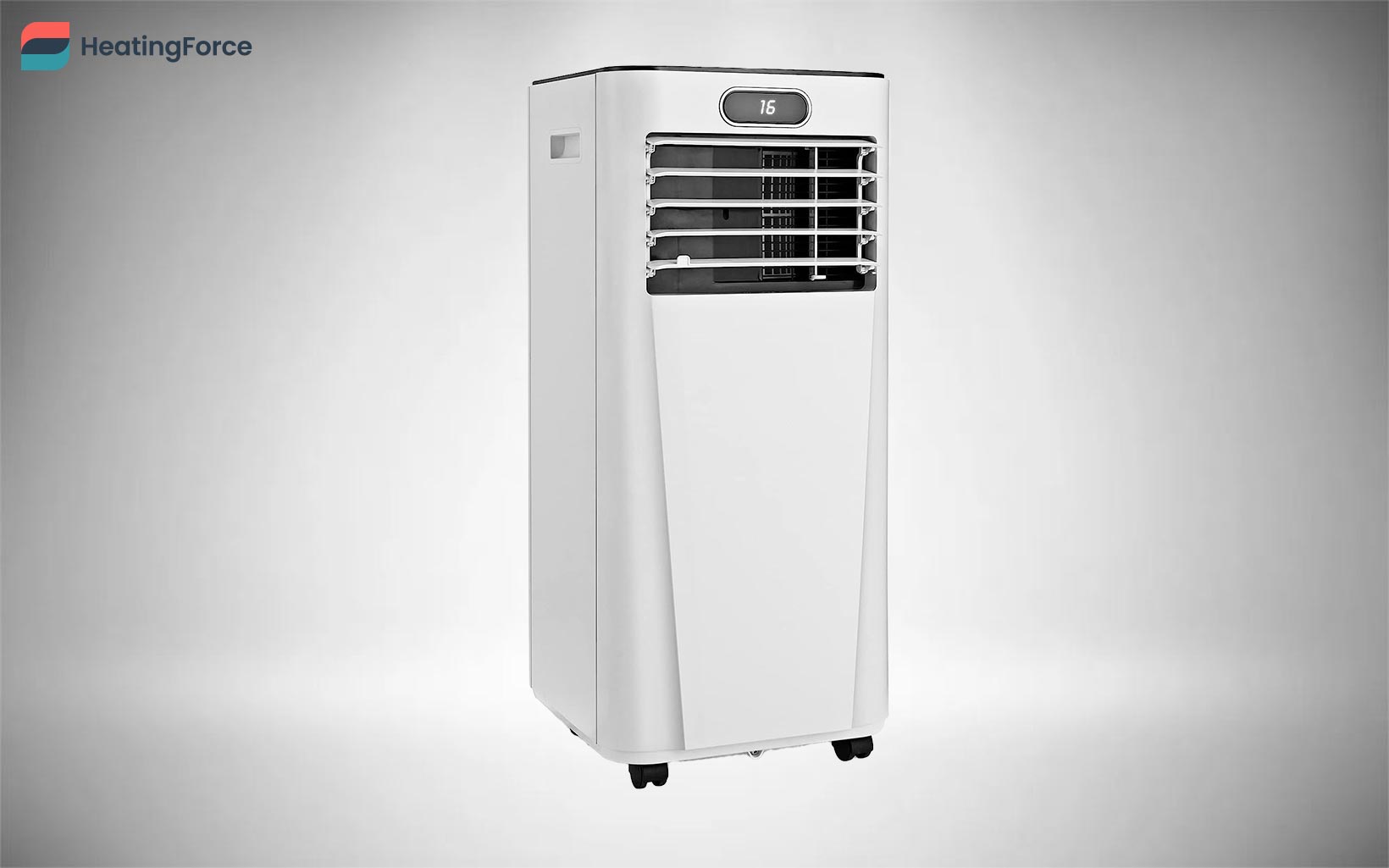
The Tangzon 7000 is one of the best small portable air conditioners on the market with a width of 31 cm and a depth of 31 cm, making it the same size as the Avalla S-80. Despite the same dimensions, the Tangzon 7000 is more powerful than the S-80, boasting a cooling capacity of 7,000 BTUs (enough to cool 250-300 square feet of space).
The Tangzon 7000 is one of the quietest portable air conditioners on the market with a noise level of 54 decibels, which is around the volume of an electric toothbrush.
This portable air-con has wheels and two handles for easy movement, a remote control that works at a distance of 5 metres, 2 fan speeds, and can remove 19 litres of water from the air every 24 hours.
Customers with a tight budget should consider the Tangzon 7000 given its low price point. The table below provides a reference for the costs associated with running a Tangzon 7000.
| Tangzon 7000 | |
|---|---|
| Purchase cost | £200 – £400 |
| Power consumption | 1.0 kWh |
| Running cost per hour | £0.34 – £0.70 |
| Running cost per month* | £61.20 – £126 |
You should consider the Tangzon 7000 if you want a moderately powerful portable air conditioner at a reasonable price that can fit in most apartments. The Avalla S-80 makes a good alternative if you want a portable air conditioner that’s even quieter than the Tangzon 7000.
Challenge 5,000 portable air conditioner
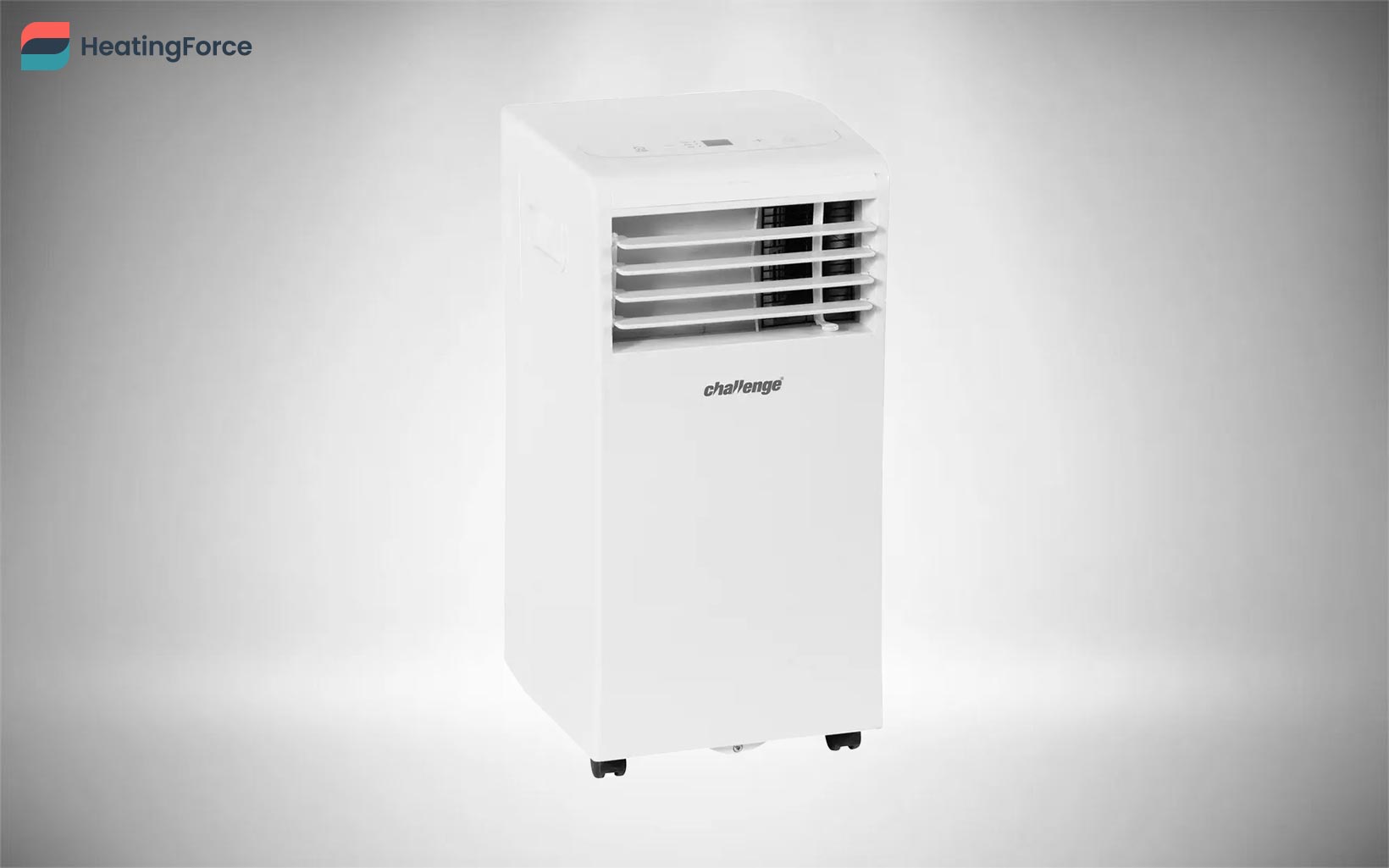
The Challenge 5000 is small with a footprint of 32.9 cm by 31.8 cm and a height of just 63.4 cm. Those dimensions make the Challenge 5000 one of the shortest portable air conditioners on the market and a great choice if you want to store your portable air conditioner under a table or cabinet.
The 5000 produces 62 decibels of noise or the volume of a normal conversation from a few feet away and comes with a remote control, a 24-hour timer, a 2-speed fan, and castors for easy movement.
The major disadvantage of the Challenge 5000 is its poor capacity compared to other units on this list. The 5000 cools only 100 – 150 square feet of space effectively.
Running costs for the Challenge 5000 are among the lowest on the market, whilst the purchase price is average. The table below provides the approximate costs of owning and running the Challenge 5000.
| Challenge 5000 | |
|---|---|
| Purchase cost | £300 – £500 |
| Power consumption | 0.67 kWh |
| Running cost per hour | £0.23 – £0.47 |
| Running cost per month* | £41.61 – £85.68 |
We recommend the Challenge 5000 for customers on a budget who plan to run their portable air conditioner for long periods during the day. Savings due to low operating costs will add up over time and offset your initial investment. You should not get the Challenge 5000 if you have a large space you need to cool. The best alternative to the Challenge 5000 is the Avalla S-80. The Avalla S-80 has a capacity of 5,000 BTUs, the same as the Challenge 5000. The two units have a very similar footprint with the Challenge 5000 having a footprint of 32.9 cm x 31.8 cm compared to the Avalla S-80 has a footprint of 31 cm x 31.5 cm.
Best portable air conditioners for the bedroom
The five best portable air conditioners for your bedroom are as follows.
- BLU-09 9000: The BLU-09 9000 is one of the best portable air conditioners for the bedroom because of its quiet profile, high capacity, and low price.
- Avalla S-80: The Avalla S-80 Portable Air Conditioner is one of the best on the market for bedrooms because it produces just 50 decibels of noise. That’s a similar volume to moderate rainfall.
- MeacoCool MC Series 7000: The MeacoCool MC Series 7000 is one of the best portable air conditioners for bedrooms on the market because it produces just 53 dB of noise. That’s quieter than most home appliances.
- HomCom 8000: The HomCom 8000 produces a decibel level of 50 dB, making it one of the quietest portable air conditioners on the market and a great option for your bedroom. 50 decibels is around the volume of a quiet refrigerator.
- Meaco 14000: The Meaco 14000 produces a decibel level of 54 dB and makes a great choice for your bedroom as a result. A fact that is especially impressive given the Meaco’s high cooling capacity. 54 decibels is around the volume of moderate rainfall.
BLU-09 9,000 portable air conditioner
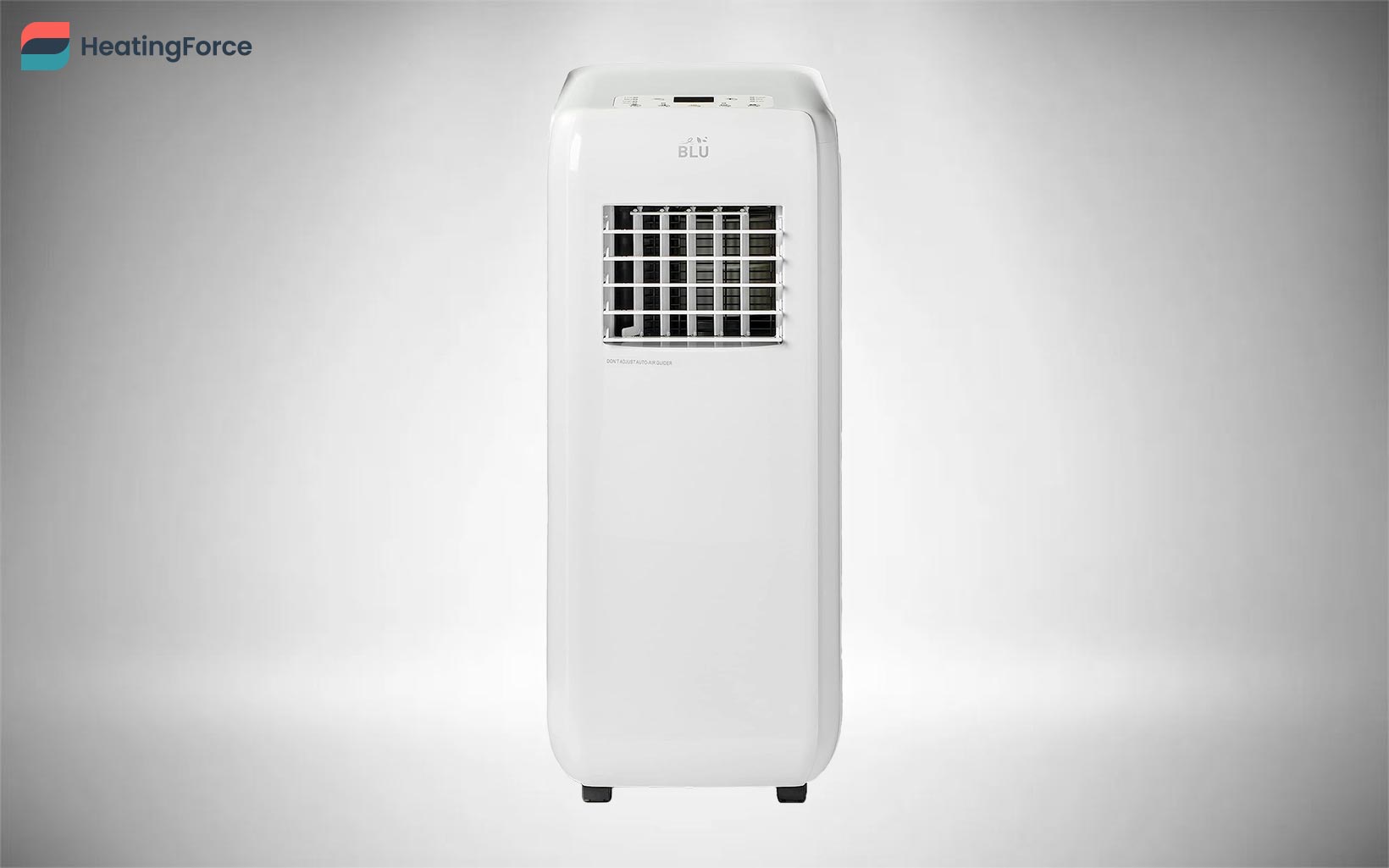
The BLU-09 9000 is one of the best portable air conditioners for the bedroom because of its quiet profile, high capacity, and low price. The BLU-09 9000’s 49 – 53 dB of noise makes it the quietest portable air conditioner on this list, perfect for getting a good night’s sleep. 49 – 53 decibels is around the volume of an electric toothbrush.
There are four advantages to getting the BLU-09 portable air conditioner. Firstly, this air-con has a high capacity of 9,000 BTUs, which is enough to cool a room of 350 – 400 square feet. Secondly, the BLU-09 is environmentally friendly because it uses R290, a refrigerant-grade propane. R290 is less damaging to the ozone layer than alternative refrigerants available on the market today. Thirdly, the BLU-09 features a self-evaporating function, which reduces the frequency with which you need to replace the condensation tray. The BLU-09 recycles around half the condensate water and uses it to cool the internal cooling coils. The fourth advantage of the BLU-09 is its reasonable price point, especially given the unit’s relatively powerful output and quiet profile. The table below shows the costs associated with buying and running a BLU-09 9000 portable air conditioner.
| BLU-09 9000 | |
|---|---|
| Purchase cost | £300 – £500 |
| Power consumption | 2.5 kWh |
| Running cost per hour | £0.34 – £0.70 |
| Running cost per month* | £61.20 – £126 |
The BLU-09 is the perfect portable air conditioner for someone who wants to leave their air conditioner running during the night and also wants a balance between price and power. The best alternative to the BLU-09 9000 is the HomCom 8000. The HomCom 8000 has a capacity of 8,000 BTUs which is only slightly smaller than the BLU-09 9000. The two units have the same volume level of around 50 decibels.
Avalla S-80 portable air conditioner

The Avalla S-80 Portable Air Conditioner is one of the best on the market for bedrooms because it produces just 50 decibels of noise. That’s a similar volume to moderate rainfall and makes the Avalla S-80 the quietest portable air conditioner we considered.
One disadvantage of the Avalla S-80 is its low cooling capacity of just 5,000 BTUs, which is only enough power to cool a room of 100 – 150 square feet. That means the Avalla S-80 would be a poor choice for larger bedrooms.
Other Avalla S-80 features include a 12L dehumidifier capacity, a built-in temperature sensor, a child lock, and a 24-hour timer. The S-80 also comes with a two-year warranty and lifetime product support.
The below table shows the costs linked with owning and operating the Avalla S-80.
| Avalla S-80 | |
|---|---|
| Purchase cost | £300 – £500 |
| Power consumption | 1.5 kWh |
| Running cost per hour | £0.51 – £1.05 |
| Running cost per month* | £91.80 – £189 |
We recommend the Avalla S-80 for anyone looking for the quietest possible portable air conditioner who doesn’t mind a relatively low power capacity. The best alternative to the Avalla S-80 is the MeacoCool MC Series 7000. The MeacoCool MC Series 7000 has a cooling capacity of 7,000 BTUs which is slightly more powerful than the Avalla S-80. Both units sell for a similar retail price of around £300 – £500, with the MC 700 being slightly more powerful. Both units are also in the lower end of 50 – 60 decibels in terms of noise.
MeacoCool MC Series 7000 portable air conditioner

The MeacoCool MC Series 7000 is one of the best portable air conditioners for bedrooms on the market because it produces just 53 dB of noise, which is quieter than most home appliances. The MeacoCool MC features an extra-low fan speed for less intrusive cooling, an on-unit display and remote, and a two-year parts and labour warranty.
The MeacoCool MC has a capacity of 7,000 BTUs—low for most air conditioners but impressive given its low noise profile and price. The below table indicates the predicted purchase and running costs associated with the MeacoCool MC Series 7000.
| MeacoCool MC Series 7000 | |
|---|---|
| Purchase cost | £300 – £400 |
| Power consumption | 0.78 kWh |
| Running cost per hour | £0.27 – £0.55 |
| Running cost per month* | £47.73 – £98 |
You should consider the MeacoCool MC Series 7000 if you have limited storage space and want an air conditioner that can run quietly while you sleep. The best alternative to the MeacoCool MC Series 7000 is the Avalla S-80, discussed above. The Avalla S-80 is slightly quieter than the MC Series 7000 at 50 decibels compared to the MeacoCool’s 53 decibels. The Avalla S-80 has a slightly lower capacity at 5,000 BTUs.
HomCom 8000 portable air conditioner
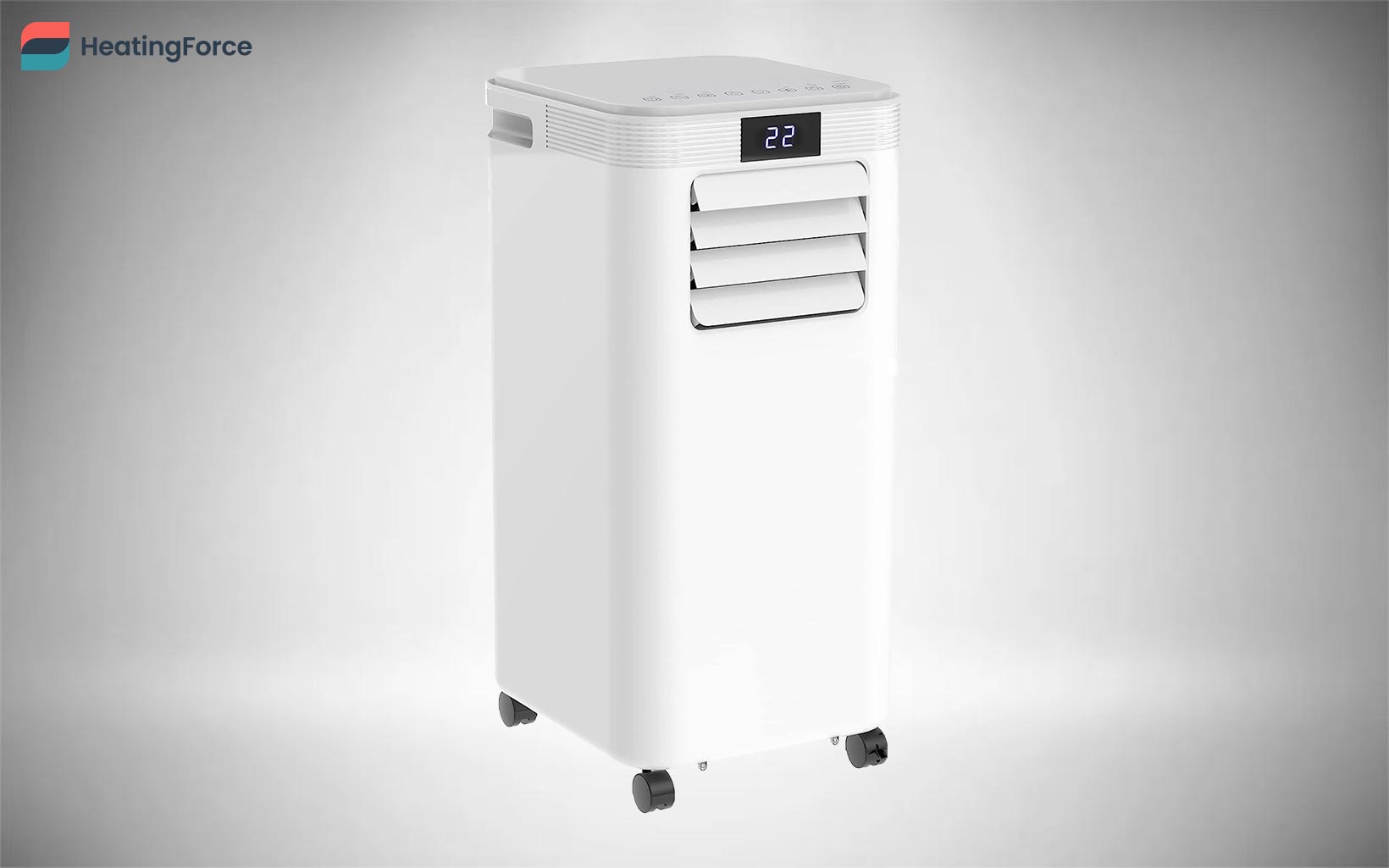
The HomCom 8000 produces a decibel level of 50 dB and is consequently one of the quietest portable air conditioners on the market.
The 8,000 BTU capacity of the HomCom 8000 is impressive given its noise level. That’s enough cooling power to effectively cool a 350-square-foot room and may even be enough for a small, one-bedroom flat. Other attractive HomCom 8000 features include an on-unit LED screen, remote control, a 24-hour timer, auto-shut-off when the water trap is full, and a relatively low price point.
The below table outlines the costs of buying and operating the HomCom 8000.
| HomCom 8000 | |
|---|---|
| Purchase cost | £250 – £350 |
| Power consumption | 0.78 kWh |
| Running cost per hour | £0.30 – £0.63 |
| Running cost per month* | £55.08 – £113.40 |
The HomCom 8000 is a fitting choice for those who want a quiet but powerful air conditioner on a budget. The best alternative to the HomCom 8000 is the BLU-09 9000. The BLU-09 9000 has a similar capacity to the HomCom 8000 with 9,000 BTUs of cooling power. The BLU-09 is also a similar volume to HomCom 8000 at 50 decibels.
Meaco 14000 portable air conditioner

The Meaco 14000 produces a decibel level of 54 dB, which makes it an acceptable air-con to use while sleeping. 54 decibels is around the volume of moderate rainfall, a fact that is especially impressive given the Meaco’s high cooling capacity of 14,000 BTUs — enough for a 550-square-foot space.
The Meaco is reasonably priced given its quiet operation and high cooling output. The table below shows the cost of buying and running the Meaco 14000.
| Meaco 14000 | |
|---|---|
| Purchase cost | £450 – £650 |
| Power consumption | 1.5 kWh |
| Running cost per hour | £0.51 – £1.05 |
| Running cost per month* | £91.80 – £189 |
We recommend the Meaco 14000 for anyone who needs to cool a lot of space without making a lot of noise. You’ll also have to be ok with a less-than-sleek air design. The best alternative to the Meaco 14000 is the Black and Decker BXAC4000. The Black and Decker BXAC400 is almost as powerful as the Meaco 14000 at 12,000 BTUs. The two units are similarly priced in the £400 – £700 range. The major downside when considering the Black and Decker as a bedroom unit is that the BXAC4000 is much louder than the Meaco 14000 at 65 decibels.
Best budget air conditioners
The five best budget air conditioners are as follows.
- Challenge 5,000: The Challenge 5000 is one of the best budget air conditioners at just £300 – £500 retail and is also one of the most affordable to run with an hourly cost of around 23p – 47p.
- BLU-09 9,000: The BLU–09 9000 is one of the best-value air conditioners on the market with a retail cost of £300 – £500 and an impressive heating capacity of 9,000 BTUs.
- Tangzon 7000: The Tangzon 7000 is one of the more affordable portable air conditioning units on the market at just £200 – £400 retail.
- HomCom 7000: The HomCom 7000 is one of the best budget air conditioners in the UK with a retail cost of £200 – £400.
- Princess Mobile Air Conditioner 7000: The Princess Mobile Air Conditioner 7000 is one of the most affordable on the market at £200 – £400 retail.
Challenge 5,000 portable air conditioner

The Challenge 5000 is one of the more affordable portable air conditioners on the market. with a retail cost of £300 – £500. The table below outlines the cost of running the Challenge 5000.
| Challenge 5000 | |
|---|---|
| Purchase cost | £300 – £500 |
| Power consumption | 0.67 kWh |
| Running cost per hour | £0.23 – £0.47 |
| Running cost per month* | £41.61 – £85.68 |
The Challenge 5000 has a 24-hour timer, a 2-speed fan, and castors for easy movement to make up for its shortcomings. The unit produces a decibel level of 62 dB, which is the volume of a normal conversation or a dishwasher.
Size should not be a concern with the Challenge 5000, as the unit has a footprint of 32.9 cm wide and 31.8 cm deep. Its height of 63.4 cm makes it the shortest portable air conditioner we considered.
One issue is that the Challenge 5,000 only has enough capacity to cool a room of 100 – 150 square feet, which is the size of a small bedroom.
We recommend the Challenge 5000 for those operating on a tight budget who plan to run their air conditioner for long periods. Low operating costs will save you a lot of money over the long term. The Challenge 5000 is not a good choice if you plan to cool a larger space. The best alternative to the Challenge 5000 is the Avalla S-80. The Avalla S-80 is at a similar price point to the Challenge 5000 with a retail price of £300 – £500. The two units also have the same cooling capacity of 5,000 BTUs.
BLU-09 9,000 portable air conditioner

The BLU–09 9000 is one of the best-value air conditioners on the market. The unit features an impressive heating capacity of 9,000 BTUs, which is enough to cool a room of 350 – 400 square feet. And an output of 9,000 BTUs is as good as you are likely to get for under £400. The table below outlines the approximate running costs of the BLU-09 9000.
| BLU-09 9000 | |
|---|---|
| Purchase cost | £300 – £500 |
| Power consumption | 2.5 kWh |
| Running cost per hour | £0.34 – £0.70 |
| Running cost per month* | £61.20 – £126 |
The best alternative to the BLU-09 9000 is the HomCom 8000. The HomCom 8000 has a slightly lower cool capacity at 8,000 BTUs. The HomCom 8000 is also priced reasonably at £250 – £350 retail, which makes it slightly more affordable than the BLU-09.
Tangzon 7000 portable air conditioner

The Tangzon 7000 is a highly affordable portable air conditioning unit considering its mid-range cooling capacity of 7,000 BTUs. The table below shows the costs associated with buying and running a Tangzon 7000.
| Tangzon 7000 | |
|---|---|
| Purchase cost | £200 – £400 |
| Power consumption | 1.0 kWh |
| Running cost per hour | £0.34 – £0.70 |
| Running cost per month* | £61.20 – £126 |
We recommend the Tangzon for those who want a budget air conditioner with a reasonable power output that won’t be disruptive. The Tangzon 7000 will fail to cool larger spaces but should be good enough for casual domestic use in the UK. Meanwhile, the best alternative to the Tangzon 7000 is the HomCom 7000, which we explore in the following subsection. Both units share a cooling capacity of 7,000 BTUs. The Tangzon 7000 and the HomCom 7000 also both cost £200 – £400 to buy.
HomCom 7000 portable air conditioner
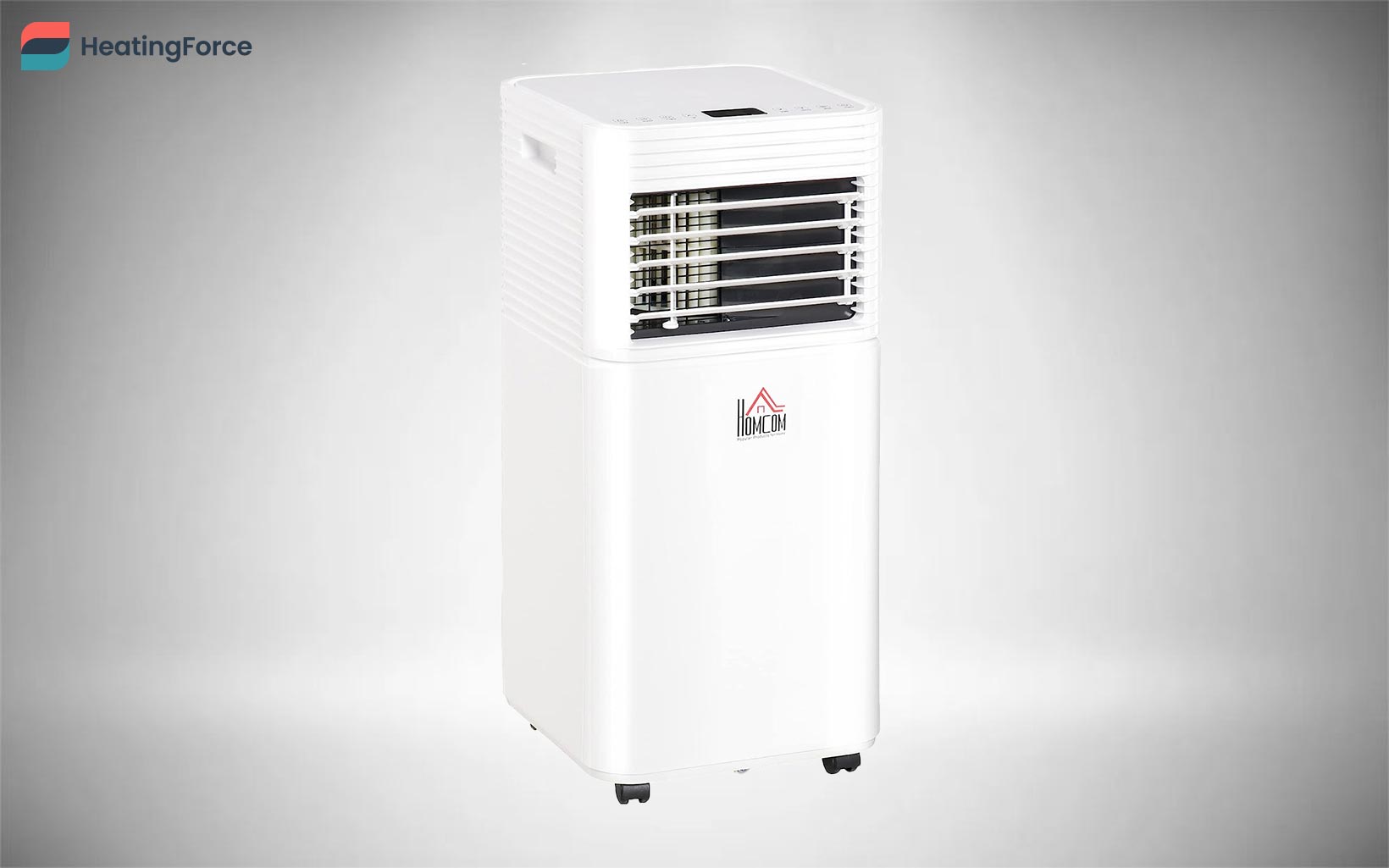
The HomCom 7000 is one of the most budget-friendly portable air conditioners on the UK market. The below table confirms the expected cost to run the HomCom 7000.
| HomCom 7000 | |
|---|---|
| Purchase cost | £200 – £400 |
| Power consumption | 0.78 kWh |
| Running cost per hour | £0.26 – £0.54 |
| Running cost per month* | £47.73 – £98 |
The unit’s 7,000 BTU capacity is impressive given its low retail price. You should consider the HomCom 7000 if you have a small space you want to cool but want to balance power and your budget. The best alternative to the HomCom 7000 is the Tangzon 7000, which shares the HomCom 7000’s 7,000 BTU cooling capacity and has the same sticker price of £200 – £400.
Princess Mobile Air Conditioner 7000
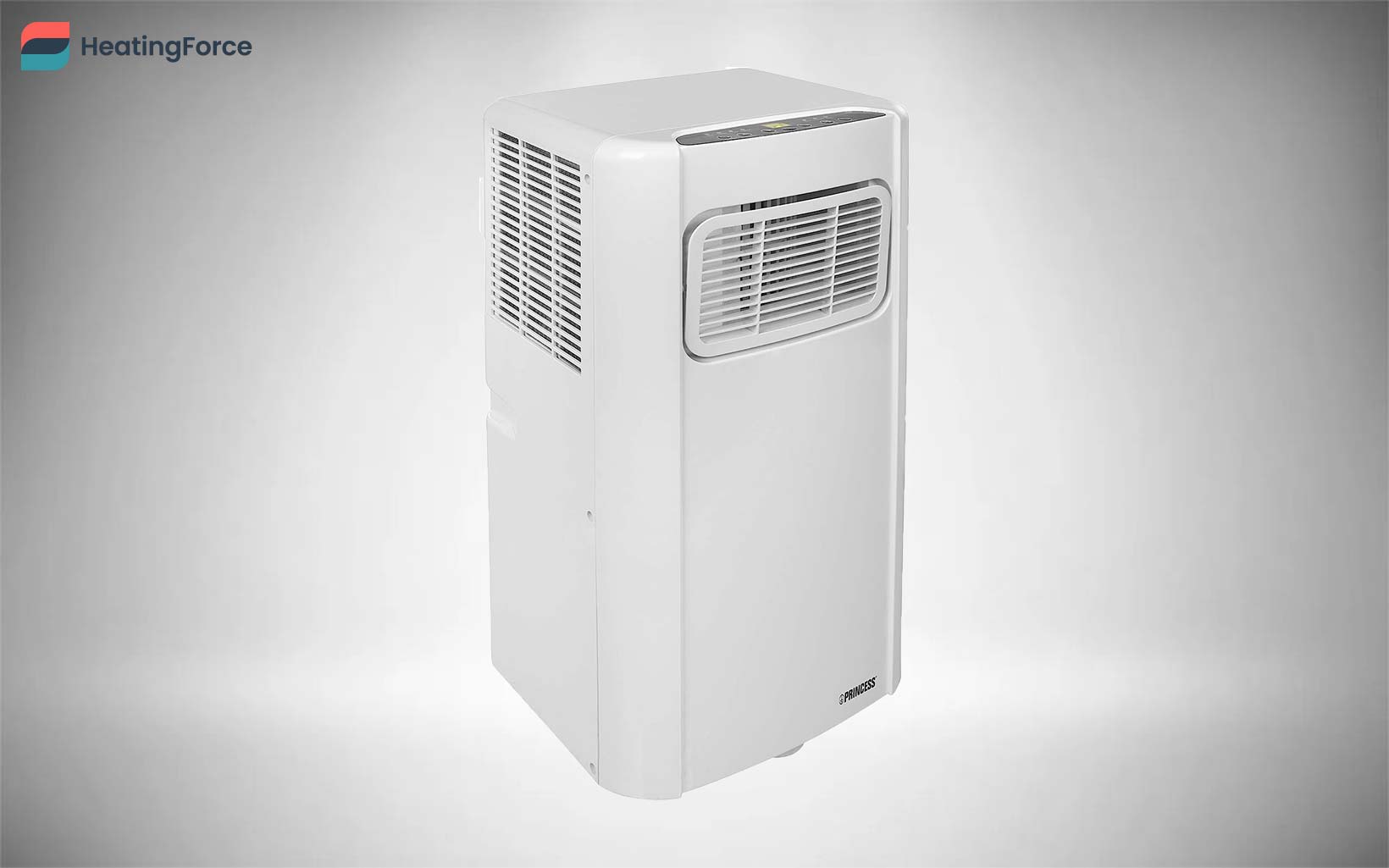
The Princess Mobile Air Conditioner 7000 is one of the most affordable air-cons to purchase and operate.The below table outlines the buying and running costs of the Princess Mobile Air Conditioner 7000.
| Princess Mobile Air Conditioner 7000 | |
|---|---|
| Purchase cost | £200 – £400 |
| Power consumption | 0.78 kWh |
| Running cost per hour | £0.26 – £0.54 |
| Running cost per month* | £47.73 – £98 |
You may be surprised that a portable air conditioner as affordable as the Princess 7000 has enough cooling capacity to keep a large room cool. Otherwise, the Princess 7000 has fairly typical accessories and features compared to the other boilers on this list. The 7000 has a digital display, remote control, easy-steer wheels, a .5 litre dehumidifier tank, and produces an expected 65 dB of noise.
We recommend the Princess Mobile Air Conditioner 7000 if you want a relatively powerful portable air conditioner for a reasonable price. Meanwhile, the best alternative to the Princess 7000 is the HomCom 7000. The HomCom 7,000 has the same cooling capacity as the Princess 7000 at 7,000 BTUs and both units cost the same at £200 – £400 retail.
How do portable air conditioners work?
A portable air conditioner works like any other air conditioner: by pulling heat out of the interior air and moving the hot air outdoors through an exhaust pipe. The interior of a portable air conditioner is split into two sections, between which the refrigerant circulates. The evaporator section houses a blower that channels warm indoor air over the cold evaporator coil, thus pulling heat from the interior air into the circulating refrigerant. The condenser section contains a fan that blows indoor air over the hot condenser coils, thus expelling heat from the refrigerant and moving it outdoors.

Are portable air conditioners any good?
Yes, portable air conditioners are good. Portable air conditioners are an affordable upgrade to a fan or an evaporative cooler. Portable air conditioners have a typically lower capacity than window air conditioners or other installed conditioning systems but come at a significantly lower cost with similar benefits as a traditional unit.
How to vent a portable air conditioner without a window?
Vent a portable air conditioner without a window by placing the exhaust pipe through a sliding door, a dryer vent, or the chimney. Portable air conditioners need an exhaust tube in order to get rid of the hot air conditioning generated. That tube needs to lead out your home somewhere but that outlet doesn’t have to be a window. For example, many portable air conditioners come with kits that help them attach to a sliding door.
Is portable air conditioner exhaust harmful?
No, portable air conditioner exhaust is not harmful. The exhaust hose of a portable air conditioner expels air that blows over the unit’s hot condenser coil. There are no harmful gases in this air if the unit is operating normally. However, the exhaust air may be harmful if your portable air-con’s refrigerant is freon, and the coils are allowing the refrigerant to leak. Luckily, the latter scenario isn’t likely to unfold for two key reasons. Firstly, modern portable air conditioners use the safe puron refrigerant, not harmful freon. Secondly, refrigerant leaks are uncommon, and their accompanying hissing noise typically alerts the user of a leak before it becomes dangerous.
Is there a portable air conditioner without a hose?
No, there is no portable air conditioner without a hose. Hoses are used to channel the hot air generated by the air conditioner outdoors. An air conditioner without a hose would not effectively cool down your interior space because it would produce both hot and cold air. Other types of air conditioners also deposit heat outside by working alongside an external unit. However, you can have an evaporator cooler without a hose. An evaporator cooler is not an air conditioner, but it is able to cool down interior spaces by using a fan and a wet pat. The evaporation of the water absorbs heat from the air and the fan distributes that cooled air around the room.
How do ventless air conditioners work?
Ventless air conditioners (also known as “evaporative coolers” and “swamp coolers”) work by blowing air over a water reservoir, thus infusing it with cool moisture. A ventless air conditioner relies on the following four components to operate.
- Water reservoir: The reservoir stores water.
- Pump: The pump pulls the water out of a reservoir and directs it over the evaporative pad.
- Evaporative pad: The pad acts as an evaporative medium through which the fan blows hot, dry air.
- Fan: The fan blows air through the evaporative pad, thus cooling it and infusing it with humidity.
A ventless air conditioner is technically not an air conditioner because it doesn’t have a system for transferring heat from the indoors to the outdoors. Traditional air conditioners use a refrigerant and a compressor to absorb heat from the air in your home and transfer that heat outside. Ventless air conditioners are only able to absorb a small amount of heat from your home environment by using that energy to evaporate water, which limits their cooling capacity.
There are five advantages to choosing a ventless air conditioner over a portable air conditioner. First, ventless air conditioners are much cheaper than traditional air conditioners, with many units costing less than £100. Second, ventless coolers require no installation. Third, ventless coolers are light and compact, making them easy to move from location to location. Fourth, ventless air conditioners are cheap to maintain, and you’re able to fix most problems yourself without calling a professional. Finally, ventless air conditioners do not need to be vented to the outdoors, unlike portable air conditioners.
Conversely, there are three disadvantages to choosing a ventless air conditioner over a portable air conditioner. First, a ventless air conditioner has a much lower cooling capacity than a portable air conditioner. Ventless air conditioners only cool air using evaporation and there is a limit to how much they can reduce your home’s temperature. Second, ventless air conditioners do not work effectively in humid climates. Ventless air conditioners need water to evaporate to cool your home, which happens very slowly in humid environments. Thirdly, ventless air conditioners may humidify your home, causing you to feel more thermal discomfort if your home is already hot and humid.
How much does a portable air conditioner cost to run?
A portable air conditioner costs £54 – £180 per month to run for 6 hours a day. This operating cost range is based on a typical portable air-con power consumption of 0.9-2.0 kWh and on electric unit rates that vary between 34 – 50 p per kWh. Portable air conditioners are consequently one of the most affordable air-con options on the market.
Do I need an air conditioner in the UK?
You may need an air conditioner in the UK due to the increasing intensity and severity of heat waves. Air conditioning used to be unnecessary in the UK, but our weather patterns have been changing over the past few decades. Recent studies indicate that the likelihood of temperatures hitting 40°C in the nation is 10 times higher now thanks to the effects of climate change. In fact, a July 2022 heat wave set a new UK record temperature of 40.3C in Coningsby and broke record temperatures at 56 other weather stations.
Whether or not you need an air conditioner in the UK depends on the following three factors.
- Health: Excess heat puts you at increased risk of heat stroke or dehydration. Certain people, such as the elderly, are at greater risk for heat-related health conditions than others. Consider getting an air conditioner if you fit into one of these categories.
- Local climate: Some areas of the UK are warmer than others during the summer. You probably don’t need an air conditioner if you live in the north of Scotland, but those living in the south might benefit from an air conditioning unit during the hotter summer months.
- Heat accumulation: Certain properties are more prone to accumulating and retaining heat than others. Top-floor flats of highrise buildings are generally exposed to more heat because hot air moves up through convection inside the building and because there’s less shade to block solar radiation. At the same time, concrete and brick buildings retain more heat because these two building materials have a high thermal mass (i.e. concrete and brick take longer to dissipate heat). Consequently, anyone living on the top floor of a concrete highrise should consider getting an air conditioner.
Cooling systems are becoming a new necessity, but portable air conditioners in particular may not be suitable for everyone. Not every home has a well-located window in which to place the exhaust hose that a portable air conditioner needs. Portable air conditioners are expensive, at several hundred pounds each, even though they are a cheaper alternative to traditional air conditioning. There are alternatives to portable air conditioners for families who don’t find them feasible, including fans and evaporative coolers.
What are the best alternatives to a portable air conditioner?
The best alternatives to a portable air conditioner are window air conditioners, air coolers, and fans. Window air conditioners are able to cool larger spaces than portable air conditioners and take up less space but cost more and are more challenging to install. Air coolers work well in dry climates and cost less than portable air conditioners, but are unreliable in humidity and have limited cooling power. Meanwhile, fans are the most portable air-con affordable alternative and keep you comfortable during the occasional hot spell, but don’t reduce the temperature in your home.
Window air conditioners
Window air conditioners are air conditioners that sit in the window and include both the condenser and evaporator in a single unit. Window air conditioners are a good alternative to portable air conditioners because they also do not need a separate external unit to install and also require limited installation. You just position a window air conditioner in your window to install the system, without the need to lay a refrigerant line or modify your home’s ductwork.
There are three advantages to choosing window air conditioners over portable air conditioners. First, window air conditioners often have a higher capacity than portable air conditioners and are therefore able to cool larger spaces. Second, window air conditioners can take up less living space. Portable air conditioners sit on the ground in your home and take up space that might otherwise be filled with furniture. Third, window air conditioners are generally quieter than portable air conditioners. Window air conditioners generate a similar amount of noise compared to portable air conditioners but most of that noise is outside your home. A portable air conditioner is often right next to you.
There are two disadvantages to choosing a window air conditioner over a portable air conditioner. First, window air conditioners are more expensive than portable air conditioners. Window air conditioners can cost between £500 – £1,500 depending on the unit whereas portable air conditioners are often available in the £200 – £400 range. Second, window air conditioners need a window that meets their specification. Window air conditioners won’t fit in every window and must have a large enough opening to fully fit the unit. Portable air conditioners work with a wider range of windows and can be adapted to most sizes with an appropriate screen.
Evaporative coolers
Evaporative coolers are an alternative to an air conditioning system that relies on water evaporation to cool air. Evaporative coolers make a suitable alternative to portable air conditioners because they require no installation, produce no exhaust, and operate at a low cost. Swamp coolers do not meet the definition of air conditioning because they do not transfer heat out of your home. Rather, they absorb some heat from the air as the water inside the unit evaporates.
There are three advantages to choosing an evaporative cooler over a portable air conditioner. First, evaporative coolers are much more affordable than portable air conditioners. Many swamp coolers cost less than £100, whereas portable air conditioners generally cost more than £200. Second, evaporative coolers do not need to be connected to a window. Portable air conditioners use an exhaust tube routed through a window to dispel excess heat. Swamp coolers do not move heat out of your home and so do not need a window vent. Third, evaporative coolers are a lot less expensive to run than portable air conditioners. Portable air conditioners actively cool your home’s air and consume a lot of energy in doing so. Swamp coolers only have to pump air up to a moist pad and operate a fan, using much less electricity.
There are two disadvantages to choosing an evaporative cooler over a portable air conditioner. First, a portable air conditioner is much more powerful than a swamp cooler. Swamp coolers are able to lower the air temperature slightly via the cooling effect of evaporation. In contrast, an air conditioner is capable of moving indoor heat outside. Second, air coolers only work in dry environments. Some locations are too humid for water to evaporate properly and air coolers don’t have much of an effect in areas with high humidity. Portable air conditioners work everywhere.
Fans
Fans are the lowest-cost alternative to an air conditioning system. Fans are a suitable alternative to portable air conditioners because they don’t cost much to operate, require no installation, and don’t need an exhaust to the outdoors.
Fans don’t cool the air in your home, but they can make you feel cooler by blowing air past you. The room temperature is generally cooler than your body’s temperature, even in hot weather. You feel warm because your body cannot get rid of the excess heat it produces as effectively in warmer temperatures. A fan helps keep you cool by bringing more air in contact with your skin, thereby helping your body dispel heat with greater effectiveness.
There are three advantages to choosing fans over portable air conditioners. First, fans are much cheaper than portable air conditioners. A basic pedestal fan may cost as little as £15, whilst the more premium models that boast air purifying and noise-reducing features may cost in the hundreds. However, average fan prices are substantially lower than the £300 – £700 you would pay for a portable air conditioner. Second, fans have lower operating costs than portable air conditioners. Fans circulate air around your living space and thus consume less electricity than portable air conditioners, which must power a blower, a fan, and a compressor. Third, fans take up less space than portable air conditioners. Portable air conditioners have a larger footprint than fans and must be positioned near a window to dispel excess heat.
